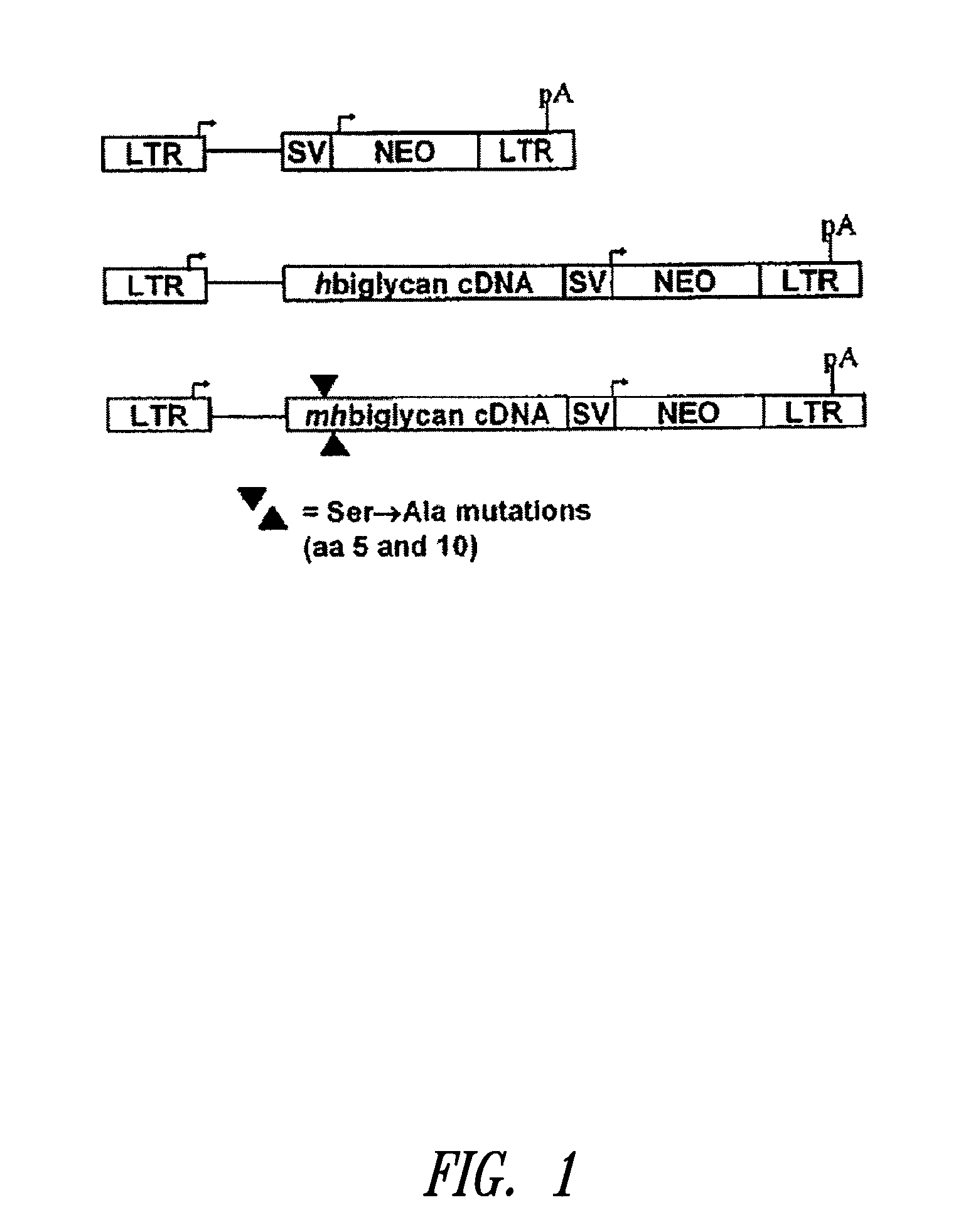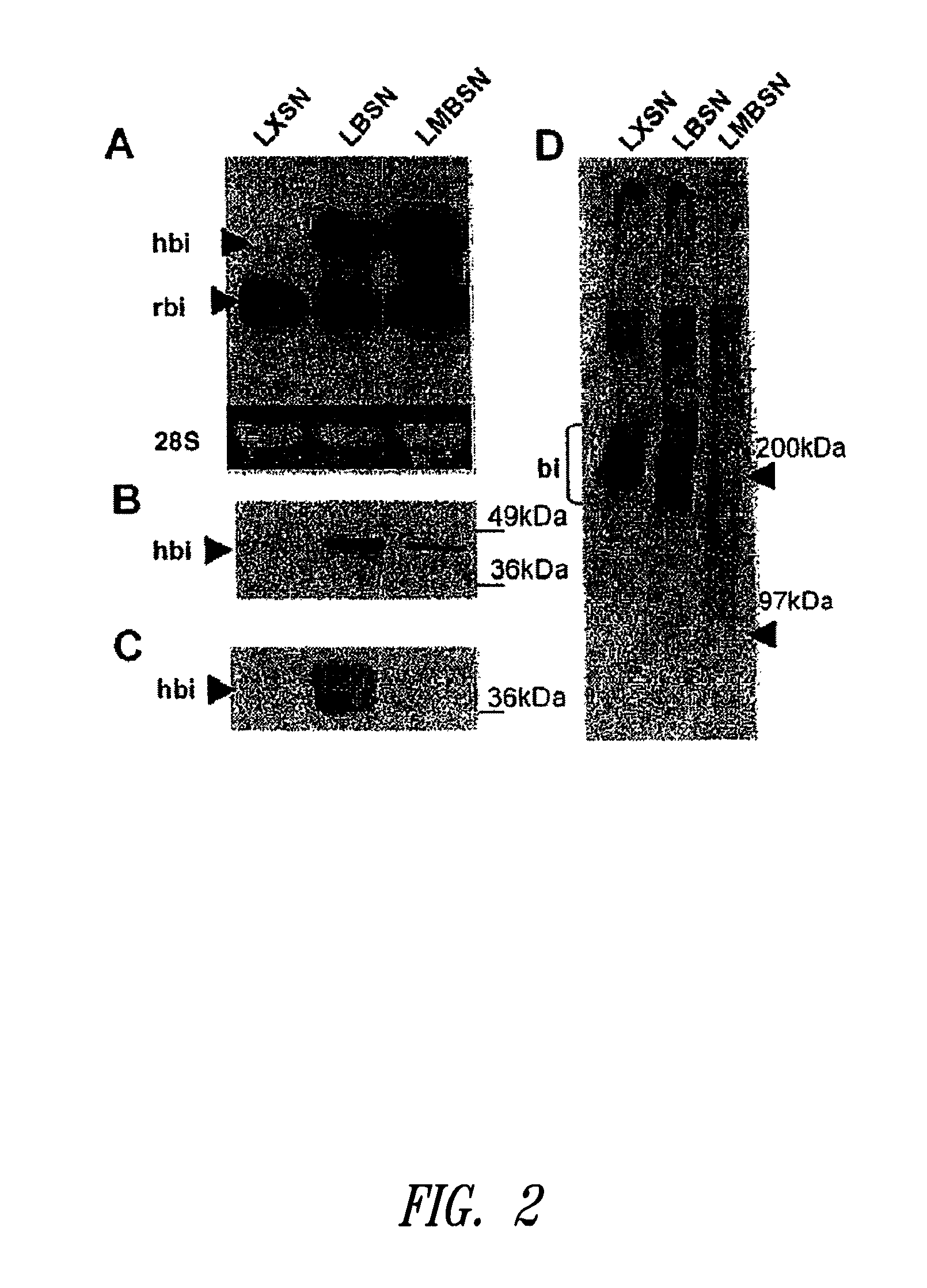Methods for promoting elastogenesis and elastin fiber formation by increasing tropoelastin expression
a technology of tropoelastin and elastin fiber, which is applied in the field of biomedical compositions and methods for treating diseases, disorders and conditions affecting connective tissues, can solve the problems of de novo elastic fiber formation, loss of tissue elasticity and resilience, and insufficient replenishment of the elastic fiber compartment of the ecm, etc., and achieve the effect of promoting elastogenesis
- Summary
- Abstract
- Description
- Claims
- Application Information
AI Technical Summary
Benefits of technology
Problems solved by technology
Method used
Image
Examples
example 1
Promotion of Elastogenesis by Mutant Biglycan Lacking GAG
[0142]This example describes mutation of the two GAG attachment sites on the core protein of human biglycan to preclude GAG chain attachment to the biglycan polypeptide. Using the retroviral vector LXSN, cultured rat smooth muscle cells were transduced with the mutated human biglycan, as well as normal (i.e., non-mutated at amino acid positions corresponding to serines at positions 5 and 10 in human biglycan, and thus capable of covalent GAG attachment) human biglycan and the empty vector as an additional control. Following characterization of the retrovirally modified cells in culture, the cells were seeded into balloon-damaged carotid arteries of adult rats to investigate effects on elastogenesis in neointima. Overexpression of mutant biglycan, without GAG chains, promoted elastogenesis in vitro and in vivo. Furthermore the increased elastogenesis was accompanied by decreased collagen synthesis and collagen fiber deposition....
example 2
Promotion of Elastogenesis by Engineered Versican V3-Derived Polypeptides
[0167]This example describes unexpected elastogenic properties of engineered versican V3-derived polypeptides that were derived from a rat V3 polymorph (SEQ ID NO:27) differing in sequence by a single amino acid substitution from a reported rat versican isoform V3 polypeptide (SEQ ID NO:26). Materials and methods were as described above in Example 1 and as described in Huang et al., 2006 Circ. Res. 98:370-377 using the LXSN viral vector system, except engineered versican V3-derived polypeptides were encoded by cDNA inserts comprising the polynucleotide sequences of SEQ ID NOS:8, 10, 12, 14, and 18, which directed, respectively, the expression of polypeptides having the amino acid sequences set forth in SEQ ID NOS:9, 11, 13, 15 and 19.
[0168]Vectors comprising polynucleotide sequences of SEQ ID NOS:16, 20, 22 and 24 are also contemplated, and may be constructed as described above, to direct the expression, respec...
example 3
Promotion of Elastogenesis by Metastatin
[0170]This example describes unexpected elastogenic properties of metastatin when administered to rat vascular smooth muscle cells and analysis of tropoelastin mRNA expression and elastin fiber formation as described in the preceding Examples and in Huang et al. (2006 Circ. Res. 98:370-377).
[0171]Metastatin was prepared and characterized as described by Liu et al. (2001 Canc. Res. 61:1022) and used to treat smooth muscle cell cultures at 20 μg / ml. To verify the hyauronan-binding activity of metastatin, preabsorption with hyaluronic acid (HA, 100 μg / ml) was performed for some experimental groups. Immunofluorescent staining of cell cultures to detect patterns of elastin distribution, and northern blot analysis for tropoelastin mRNA, were conducted as described above. Elastin immunostaining and tropoelastin mRNA levels were increased in cultures treated with metastatin, and decreased in cultures that were treated with the HA-preabsorbed metastati...
PUM
| Property | Measurement | Unit |
|---|---|---|
| temperature | aaaaa | aaaaa |
| pH | aaaaa | aaaaa |
| pH | aaaaa | aaaaa |
Abstract
Description
Claims
Application Information
 Login to View More
Login to View More - R&D
- Intellectual Property
- Life Sciences
- Materials
- Tech Scout
- Unparalleled Data Quality
- Higher Quality Content
- 60% Fewer Hallucinations
Browse by: Latest US Patents, China's latest patents, Technical Efficacy Thesaurus, Application Domain, Technology Topic, Popular Technical Reports.
© 2025 PatSnap. All rights reserved.Legal|Privacy policy|Modern Slavery Act Transparency Statement|Sitemap|About US| Contact US: help@patsnap.com



